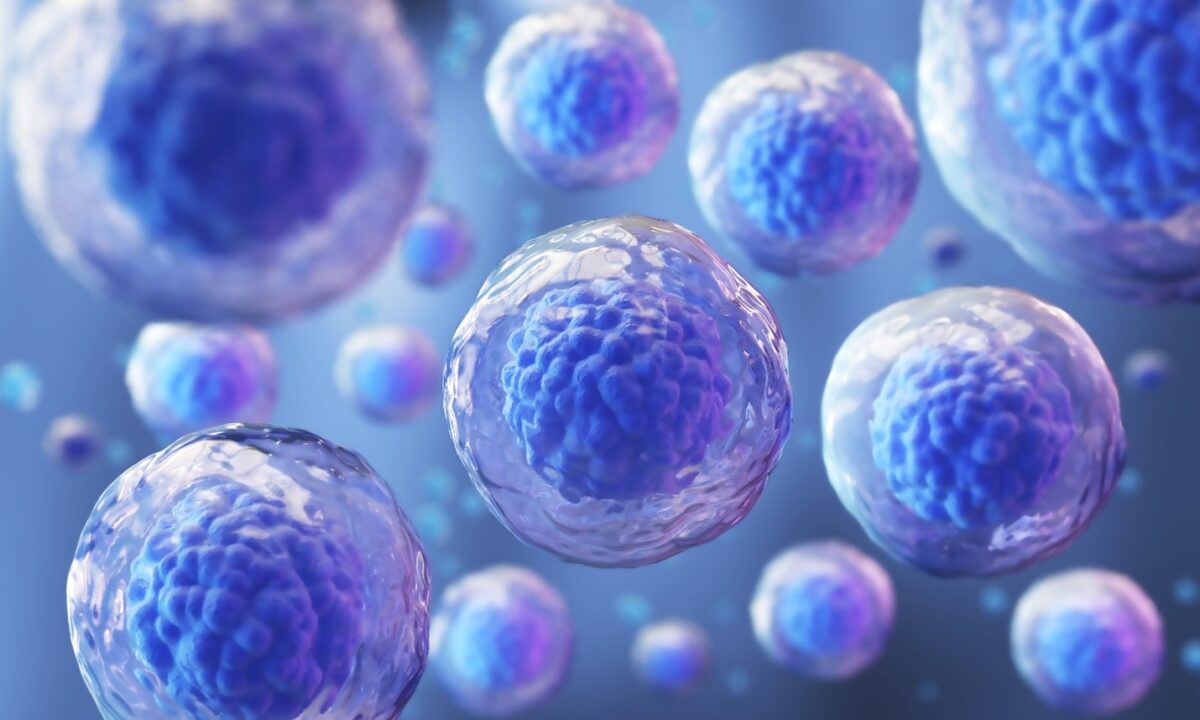One of the more intriguing developments in cancer research in recent years is the growing understanding of clonal hematopoiesis, a phenomenon where blood cells expand from a single clone due to genetic mutations. Clonal hematopoiesis increases in prevalence with age and can precede hematologic malignancies. This area of study not only provides insights into the aging process but also has significant implications for cancer diagnostics, treatment strategies and new therapy development.

R&D Director, Oncology Diagnostics
Eurofins Viracor BioPharma Services
In this Xtalks Spotlight edition, we delve deeper into the intricate relationship between clonal hematopoiesis and cancer genetics by speaking with Dr. Karina Eterovic, a leading expert in precision oncology and the R&D Director of Oncology Diagnostics at Eurofins Viracor BioPharma Services.
Dr. Eterovic brings much knowledge and experience to the table, having led the development of a new Oncology Diagnostic program at Eurofins Viracor that integrates the latest genomic profiling techniques.
The conversation highlighted the critical aspects of clonal hematopoiesis, its differentiation from tumor-specific mutations and its broader implications for cancer genetics.
More About Clonal Hematopoiesis
Clonal hematopoiesis involves the expansion of blood cells from a single hematopoietic stem cell clone. This expansion is triggered by somatic mutations — changes that occur in the DNA post-fertilization and are not inherited from parent to offspring. Although acquiring mutations is a normal part of aging, those that drive clonal expansion in blood cells can have profound health implications.
Dr. Eterovic explains that clonal hematopoiesis is not just a byproduct of aging but also a condition that could predispose individuals to both hematological and non-hematological malignancies. As we age, the likelihood of acquiring these mutations increases, which is reflected in the higher prevalence of clonal hematopoiesis in older populations. For instance, while only about one percent of individuals under 40 may show signs of clonal hematopoiesis, this rate jumps significantly — to over 15 percent — in those older than 70.
Understanding clonal hematopoiesis is crucial in cancer genetics because it has the potential to complicate the diagnosis and treatment of cancer. With the widespread adoption of next-generation sequencing (NGS) technologies, researchers and clinicians are now able to detect these mutations more frequently than ever before. However, this increased detection rate also comes with the challenge of distinguishing between mutations that are part of clonal hematopoiesis and those that are specific to cancerous tumors.
Distinguishing Clonal Hematopoiesis from Tumor Somatic Mutations
Differentiating clonal hematopoiesis mutations from tumor-specific somatic mutations is a critical challenge in oncology diagnostics. Misidentifying these mutations can lead to suboptimal treatment choices, as therapies designed to target specific tumor mutations may not be effective against clonal hematopoiesis-related changes. Dr. Eterovic emphasizes the importance of this differentiation for precise cancer treatment and improved patient outcomes.
The ideal approach to distinguish these mutations involves comprehensive genomic profiling, where both tumor DNA and germline (blood) DNA are sequenced. Dr. Eterovic points out that this dual sequencing enables clinicians to identify whether a mutation is truly somatic and unique to the tumor or part of a clonal expansion in normal hematopoietic cells. However, this method is not routinely used in clinical settings mainly due to cost concerns and the complexity of obtaining and processing multiple biological samples.
Currently, in most clinical environments, only the tumor is sequenced. This practice can inadvertently capture clonal hematopoiesis mutations, which may be mistaken for tumor-specific mutations. The consequence of this misidentification can be substantial, potentially leading to the selection of targeted therapies that are unlikely to be effective, based on the incorrect assumption that the detected mutations are driving the cancer.
Dr. Eterovic highlights that the financial and logistical barriers to comprehensive genomic profiling are high but not impossible to overcome. With the decreasing costs of sequencing technologies and a growing recognition of the importance of accurate mutation identification, there is hope that future clinical practices will use more robust genomic analyses. This would allow for a more precise approach to cancer treatment, where both tumor and germline (blood) sequencing are standard practices, thus ensuring that therapeutic decisions are based on the most accurate genetic information available. This shift could profoundly impact the effectiveness of personalized cancer therapies and ultimately enhance patient care.
Strategies Without Germline Sequencing
In the absence of germline sequencing, clinicians and researchers face the challenge of accurately interpreting genetic data from tumor samples alone. Dr. Eterovic discussed several strategies that can be employed to infer the presence of clonal hematopoiesis mutations and distinguish them from mutations that are specific to tumors:
1. Mutation-specific gene analysis: One approach is to focus on specific genes known to frequently harbor clonal hematopoiesis mutations. Databases that catalog these mutations provide valuable references that help clinicians recognize potential clonal hematopoiesis markers when they appear in tumor sequencing data. If a mutation identified in a tumor sample is also commonly associated with clonal hematopoiesis, it serves as a red flag that the mutation might not be exclusive to the cancerous cells.
2. Variant allele frequency (VAF): The VAF, which measures the proportion of a genetic variant among all copies of a gene, is another critical tool. Clonal hematopoiesis mutations generally appear with a lower VAF because they are present in a subset of blood cells, whereas mutations in tumor cells typically have higher frequencies. By analyzing the VAF, clinicians can assess whether a mutation is likely part of the germline or a somatic mutation confined to the tumor.
3. Patient age consideration: Since clonal hematopoiesis increases with age, the presence of certain mutations in older patients might more likely suggest clonal hematopoiesis. Conversely, the same mutations in younger patients might more likely be tumor-specific. Although this is not an absolute rule, age can be a helpful context for interpreting genetic variations.
Dr. Eterovic notes that while these strategies offer useful guidelines, they are not infallible. The absence of germline sequencing limits the precision of mutation classification. This limitation can lead to uncertainties in treatment planning, where a mutation might be incorrectly assumed to be relevant to the tumor’s behavior. She stresses the importance of complementing these strategies with clinical judgment and continuing research to refine the methods for identifying and interpreting clonal hematopoiesis mutations.
Ultimately, these strategies represent temporary solutions until more comprehensive genomic profiling becomes accessible and standard in clinical practice. The ongoing development of cheaper, faster and more comprehensive sequencing technologies promises to eventually overcome these challenges, leading to more precise cancer diagnostics and more effective treatment regimens.
Clonal Hematopoiesis and Hematologic Malignancies
Clonal hematopoiesis mutations can predispose individuals to a spectrum of blood cancers, including leukemia and myelodysplastic syndromes. This predisposition arises because the mutations within the hematopoietic stem cells can confer a growth advantage, leading to an expansion of cells that potentially accumulate additional mutations over time. This cumulative effect can eventually transform these cells into malignant ones.
Furthermore, Dr. Eterovic highlighted the dual impact of cytotoxic therapies, such as chemotherapy and radiation, used to treat various cancers. These treatments can induce clonal hematopoiesis by causing DNA damage that leads to additional mutations in surviving hematopoietic stem cells. Patients who have undergone such treatments are, therefore, at a heightened risk of developing secondary hematologic malignancies. While the overall risk of developing hematologic cancers from clonal hematopoiesis remains relatively low, it is not negligible, particularly in these vulnerable populations.
Monitoring patients who present with clonal hematopoiesis mutations is crucial, especially those who have received cytotoxic therapies. Regular follow-up and screening for hematologic abnormalities can help detect early signs of malignancy, potentially improving outcomes through earlier intervention.
Dr. Eterovic stressed the importance of understanding the long-term implications of clonal hematopoiesis, not only for those who naturally acquire these mutations but also for cancer survivors who might be at risk due to their treatment histories.
The Future of Clonal Hematopoiesis Research
Research into clonal hematopoiesis is rapidly evolving, and Dr. Eterovic highlighted several promising directions that could substantially impact how we understand, diagnose and treat various cancers and hematologic conditions.
As genomic technologies continue to advance and become more cost-effective, comprehensive genomic profiling that includes both tumor and germline sequencing could become routine. This would allow for a more accurate differentiation between clonal hematopoiesis-related mutations and tumor-specific mutations, leading to more personalized and effective treatment strategies. Dr. Eterovic is optimistic that with the decreasing costs and logistical improvements, such comprehensive profiling will be feasible on a larger scale in clinical settings.
There is a growing interest in running longitudinal studies to track the progression of clonal hematopoiesis over time and its clinical consequences. Additionally, mining existing genomic data sets to uncover patterns and correlations between clonal hematopoiesis mutations and various health outcomes could provide deeper insights. These studies will help to better understand the pathways through which clonal hematopoiesis mutations contribute to disease and identify potential intervention points.
Another important research goal is developing better tools for risk assessment and management of patients with clonal hematopoiesis. These tools would help clinicians decide when and how to monitor patients with clonal hematopoiesis mutations, particularly those who are at an increased risk of developing hematologic cancers or those who have been exposed to cytotoxic therapies.
Dr. Eterovic sees a transformative future for clonal hematopoiesis research, one that improves our understanding of this genetic phenomenon and translates into actionable strategies that can be applied in clinical practice. This promises to refine diagnostic accuracy, tailor treatments more effectively and ultimately improve patient outcomes.
This article was created in collaboration with the sponsoring company and the Xtalks editorial team.









Join or login to leave a comment
JOIN LOGIN